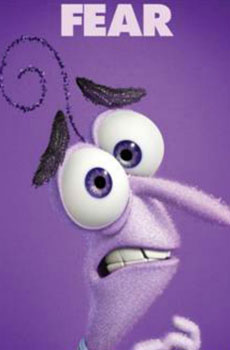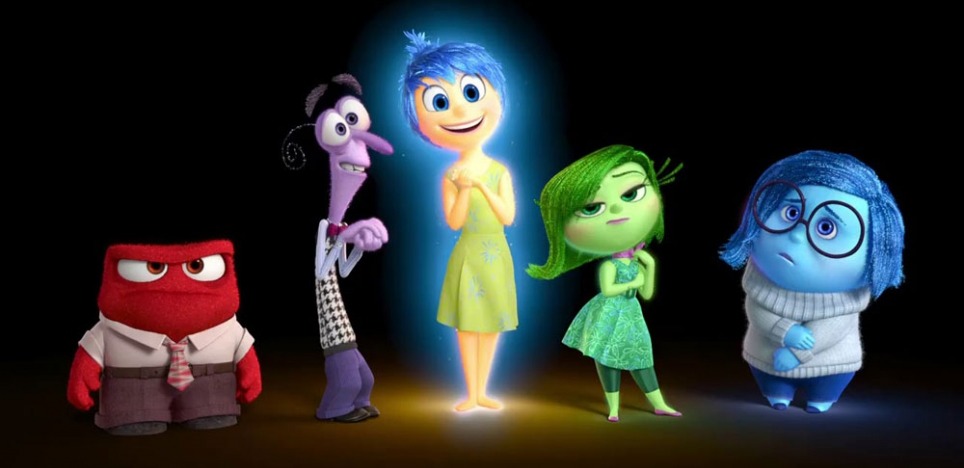In the Disney Pixar animated feature Inside Out, the filmmakers bring five emotions to life: Joy, Sadness, Disgust, Fear, and Anger. We watch them walking, talking, and otherwise expressing themselves with vigor and variety. It's easy for us to identify with these characters, their moods and their reactions.
Director Pete Docter seeks to both entertain and leave viewers with a deeper understanding of the emotions which animate our lives. He and his team spent time with psychologist Paul Ekman, who is known for his research on emotions, and Dacher Keltner, a professor of psychology at the University of California, Berkeley.
After seeing this animated film, we remembered The Book of Qualities by J. Ruth Gendler in which she personified 76 emotional and abstract human qualities from Beauty and Depression to Innocence, Honor, and Wisdom. She then talked to a junior high school English class about her approach to treating the emotions like persons and asked them to each select a quality and briefly personify it in three or four paragraphs.
Gendler was surprised by the maturity of the students as they grappled with the feelings, thoughts, and observations in these creative portraits. For example, those who chose to write about Loneliness soon discovered themselves feeling the isolation, loss, and abandonment of others. Some created dialogues between qualities, thus coming to grips with the contradictory voices within themselves. Gendler writes about this exercise in "Inner Voices: Learning about Human Qualities through Writing" (pdf).
After viewing Inside Out, you might do this exercise in your journal. Or, to work with specific emotions, try these spiritual practices.
 Joy
Joy
"Whenever you can remain centered in your inner joy, you have a different attitude about everything. You become joy itself, and you experience a great change within. The joy spreads through your whole being, and your awareness deepens it.
"Suddenly you see a friend you have not seen for many days, and you feel joy arising in your heart. But you are focused on your friend, not on your joy. You are missing something, and your joy is fleeting.
"Next time you see a friend and suddenly feel joyful, concentrate on this joy. Feel it and become it, and meet the friend while being aware of and filled with your joy. Be present for your friend, and at the same time, remain centered in your happiness.
"You can try this technique in many situations: while watching the sun rise, greeting your pet, playing ball with your child, watching a leaf float to the ground. Be centered in your joy. Instead of being object centered, become self-centered. Many people think that when we feel joy, the cause is external. That is not the case. Joy is always within you. The external situation has simply triggered the joy within you.
— Pragito Dove in Laughter, Tears, Silence
 Sadness
Sadness
"Next time you feel sadness, see if you can breathe in deeply and let go of tension as you exhale. Let your body help you work with your sadness. And the next time you feel like crying (but you can't because other people are around) observe your reaction. Most of us tense up and get very tight and arid when it's actually time to cry (this tension makes our inner situation worse, not better!) If it's not socially safe to cry, see if you can't at least relax a bit, breathe deeply, and let your body have a felt sense of letting go. It won't be as healing as a good cry, but it's better that crushing your sadness under the weight of everything you've been holding on to.
"Welcome your sadness, and if you have the chance, welcome sadness in other people as well. You have the power to change social rules about emotions, at least in your area of influence, so go you!"
— Karla Mclaren in The Language of Emotions: What Your Feelings Are Trying to Tell You
 Disgust
Disgust
"When you notice yourself caught up in a feeling,
Like resentment, rejection, or despair,
Cradle that feeling as though it were a small baby.
It may even help you to take a cushion and physically cradle the feeling in your arms.
Sing to it.
Soothe it.
Let that feeling know that it is accepted, loved, and welcomed.
In fully accepting grief,
You become acceptance itself,
Which is none other than your natural state."
— Arjuna Ardagh in Leap Before You Look
 Fear
Fear
"Frequently I devote one day where I commit myself to the practice of saying yes to fear. What this means is that upon feeling even a hint of anxiety, I practice moving toward the fear, not with the heaviness of 'my suffering' but rather with a certain lightness of heart that comes from seeing fear as nothing more than the human conditioning to which we are all subject. Without this lightness of heart, how could we ever step beyond the protective cocoon?
"The transformation of fear does not mean that we no longer have fearful responses. It means that we no longer believe that those responses are who we are. This is what practice is about: learning to stop believing that our deep-seated reactivity is who we are. Who we really are is much bigger than any of our fear-based conditioned responses. When we can really experience fear, we can see through this false identification, perhaps even glimpsing a vaster sense of Being."
— Ezra Bayda in Being Zen: Bringing Meditation to Life
 Anger
Anger
"There may be times when you are angry with someone, and you try everything you can to transform your anger, but nothing seems to work. In this case, the Buddha proposes that you give the other person a present. It sounds childish, but it is very effective. When we're angry with someone we want to hurt them. Giving them a present changes that into wanting to make them happy. So, when you are angry with someone send him a present. After you have sent it, you will stop being angry with him. It's very simple, and it always works."
— Thich Nhat Hanh in Anger: Wisdom for Cooling the Flames
